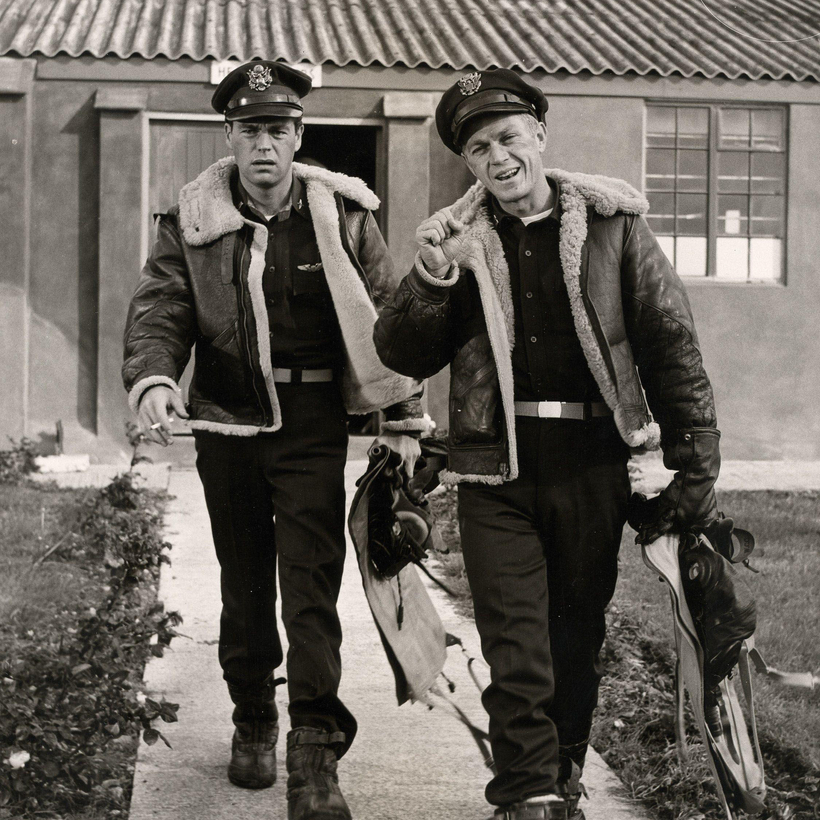A lot of people remember Love Story for Ali MacGraw’s beauty. More than a few for its theme song, by Andy Williams. And yeah, pretty much everyone remembers it for that last line.
Stuart Clurman remembers it for something else.

“The sheepskin coat that Ryan O’Neal wears? What some people call the Marlboro Man [jacket]? That is actually a classic Sawyer—that’s the company in California that used to make them. I was in graduate school when I saw that movie, and after it was over, all I wanted was that coat. But I couldn’t afford it. I was a nobody kid from the poor side of Queens. So, years later, when I had the chance, I made one. That coat changed my life.”
Lives have turned on stranger moments.
These days, Clurman is still in Queens. But he’s not a nobody. Not to guys like Daniel Day-Lewis, David Mamet, Ronnie Wood, and others who have discovered him—usually by word of mouth—and his highly prized Lost Worlds leather jackets. To them, Clurman is a secret style source they can rely on for the leather coat of their dreams.
Want a biker jacket like the one Bruce Springsteen wore nearly 50 years ago on the cover of Born to Run? He can make that. (“That’s our Speed Demon. Became the jacket for rockers.”) Maybe you want a jacket like the one Johnny Depp wore when he was dating Kate Moss in 1996? He can do that too. (“That’s the Hemi model. That fuller cut was dormant for a while, but people are liking it again.”)

While it’s relatively easy to find new coats that look like those vintage styles, Clurman’s jackets are valued because they aren’t just modern imitations of vintage styles, but exacting, made-to-measure replications of them, built with choice hides and deadstock hardware. Imagine you wanted a Ferrari 250 GTO from 1962 and found someone who had access to the original parts and knew how to build one by hand from the ground up. It’s a bit like what Clurman does.
“I make coats like they used to be made in the 50s. Before craftsmanship in America all went to shit. I don’t make cheap knockoffs of these coats. I make perfect replicas that I learned how to make after carefully studying the originals I have in my archives.”
Clurman, who is 73, looks like the movie director Samuel Fuller and speaks in a reedy voice. He started Lost Worlds in 1992 in a storefront on a stretch of Jamaica Avenue in Queens where the elevated J train screeches overhead. But don’t bother trying to visit him there. If you do, you’ll find the burglary gate pulled halfway down and the windows grimed over like they haven’t seen a squeegee since the Blackout of ’77. It’s not for a “look,” it’s pragmatic—Clurman is adamant that he does not deal with walk-in customers.

Which might be a good thing, because what’s behind the gate is not exactly the most retail-friendly environment. This is a gritty workshop where fluorescent lights flicker on Juki sewing machines from Japan, and decades of linoleum flooring have been worn thin to reveal layer upon layer. Boxes of vintage zippers and grommets clog shelves while some of Clurman’s museum-worthy archive of midcentury American jackets hang from metal rails. In the basement, rolls of horsehide and slabs of calfskin are stacked waist-high, waiting to go under the pattern cutter’s blade.
“I make coats like they used to be made in the 50s. Before craftsmanship in America all went to shit.”
The only way to get a coat from Clurman is to go to his Web site—which looks essentially as it did when he put it up at the end of the last century—pick one of the 50 styles he sells, and send him an e-mail. He’ll respond with a number of questions that help him figure out sizing, and from there, a coat is made. “The system’s a bit like phone sex,” he says. “The customers are happy, and I’m happy.”

His most popular jacket is a $1,650 horsehide replica of a style from the 1940s that was favored by bikers, truck drivers, and dockworkers. Despite the swagger this coat conveys, it’s tagged with the less-than-dangerous name “The Suburban.” The fault, it becomes clear, lies in the vintage label Clurman selected to use in it years ago, which shows a man in a Jaguar XK120. “That’s my guy!” he says, pointing to the little figure on the label and admiring it. After a moment he says, “It’s too late to change it now.”
Another Lost Worlds favorite is the J-23, a clone of a fabled motorcycle jacket from the 1950s, the Buco J-23, that was made by Joseph Buegeleisen in Detroit. It costs $2,250.
Clurman says that the majority of the men who buy his motorcycle jackets are actually riders. “But,” he says, “every once in a while you get a dentist. There’s always a dentist.”
What sets Clurman’s coats apart, aside from the craftsmanship and the quality of his hides—he couldn’t find leather that met his standards, so he invested in an American tannery—is his fit. Like bespoke English jackets, which are known to be comfortable due to their high armholes, Clurman’s coats move with the body of the owner. He won’t reveal the complete secret to the fit, saying that his pattern-making skill is the secret, but he does divulge that any armhole is “the heart of the jacket” and any slight variance in it—too high, too forward, too recessed—renders the jacket worthless.
“But every once in a while you get a dentist. There’s always a dentist.”
“The new stuff is not cut to do what the coat was created for: working guys doing things.” He throws on a Suburban and pretends he’s reaching for the handlebars of a motorcycle, and then points out how the coat does not ride up his back, but stays tight to his body.

Spend enough time with Clurman and you realize he’s a bit like his workshop: a man out of time inside a place out of time. A former film student, he loves old movies such as Madame de … , but he’ll also tell you straight up that The Wild Bunch is the best movie ever made. (“It’s more related to the Iliad than a Western.”) He also collects French movie posters of American films from the 1960s, but he can’t afford to frame them, so they sit among the other boxes in the workshop.
Clurman thinks the movie The War Lover, with Steve McQueen, has the best bomber jackets ever shown on film.
He says he doesn’t make clothes for “fashion guys or posers or hipsters” but for customers who know what the coats were for in the first place. He says he has to be like Odysseus and “load my ears with wax in order to do things correctly, in a world that won’t.”
“When I started Lost Worlds, I wanted to see if I could do what everyone was telling me I could not do. And everything I do, how I do it, it’s from the 1950s. It’s about details and the material. Look at this …” He reaches for one of his Fairfield coats (the Love Story coat).
“No one makes things like this anymore. No one knows how to. See these buttons? They’re made from actual deer antler, the way the originals were. I get mine from an Indian reservation. And that shearling? Feel it. This isn’t something pulled off the schmatte rack, this is … ”
His voice trails off, and he looks around and seems to gather his thoughts. “I like to think that what I do, the care we take, it’s why Daniel Day-Lewis likes that Bedford model we sold him. Maybe all those years he was learning to make shoes as a cobbler in Florence gave him an appreciation of good materials. Of what I do. I know I make the best stuff out there. I love leather and what I do. Why apologize?”
He might be right. Maybe leather means never having to say you’re sorry.
Michael Hainey is a Writer at Large at AIR MAIL and a co-host of its Morning Meeting podcast


